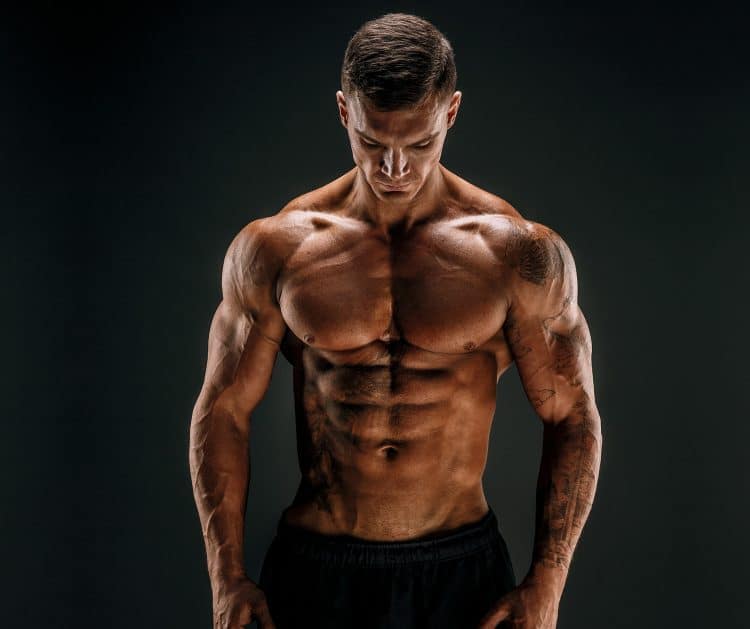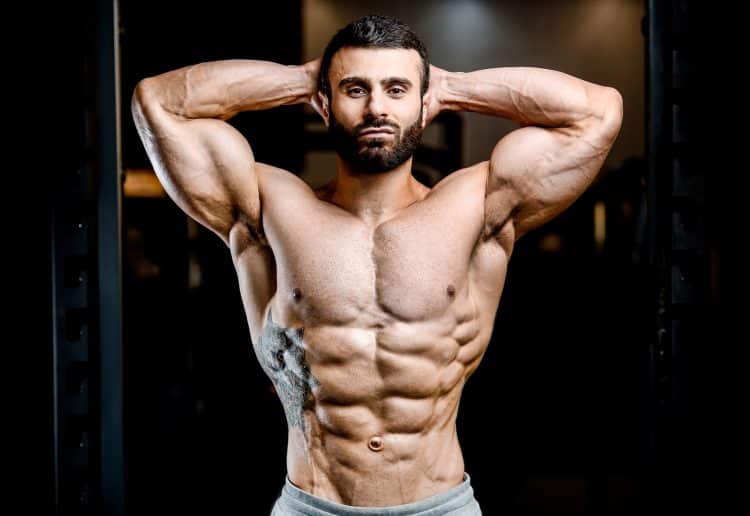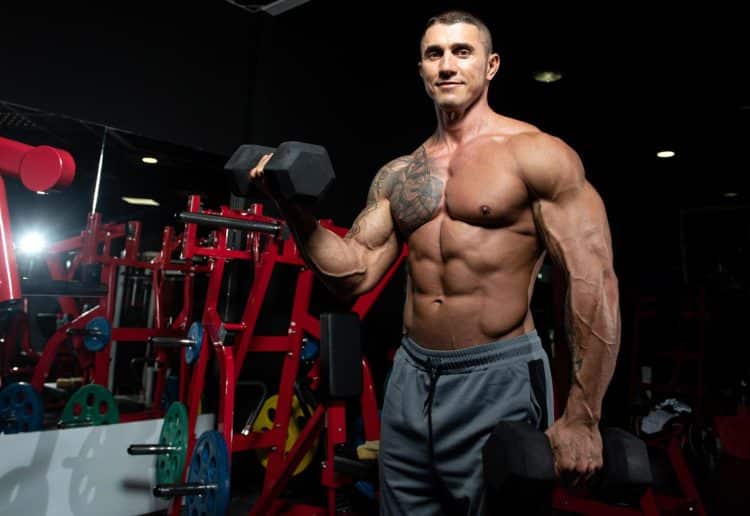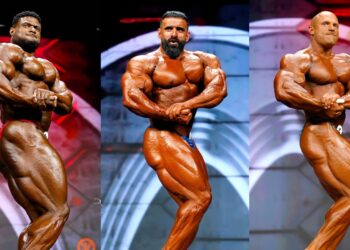Unilateral exercises like the alternating dumbbell curl, single arm leg extension, and single-arm shoulder press involve training one side of your body at a time. On the other hand, bilateral exercises like the barbell bench press, barbell biceps curl, and bent-over barbell row collectively train both sides of your body.
Due to a few reasons, a vanilla gym routine usually includes more bilateral movements than unilateral exercises. First, the former takes less time to complete. Plus, they help you handle heavier weights as you’ll be using both sides, and the compound movements can help a beginner build a solid base. Notably, most bilateral exercises have a unilateral version.
If bilateral exercises are time-efficient, require less core engagement, and build a solid foundation, why do we need unilateral movements?
Well, sticking solely to bilateral exercises has its fair share of drawbacks. If you lift with an incorrect form or have poor movement mechanics, it’ll probably be hard to fix the underlying issues while sticking to performing the lifts that have got you in the position in the first place.
In this article, we discuss the benefits of unilateral training, how to test if you need to up the number of unilateral lifts in your training regimen, and the best single-limb movements for each muscle group.
Benefits of Unilateral Training
Many strength athletes, especially powerlifters and weightlifters, usually overlook unilateral exercises as they are not a part of their main lifts. However, labeling single-limb exercises as bodybuilding movements can prove to be a big mistake.
Level Up Your Fitness: Join our 💪 strong community in Fitness Volt Newsletter. Get daily inspiration, expert-backed workouts, nutrition tips, the latest in strength sports, and the support you need to reach your goals. Subscribe for free!
Here are the benefits of adding unilateral movements to your training regimen:
1. Helps Correct Muscle Imbalances
This is arguably the biggest benefit of adding unilateral exercises to your training regimen. A gym bro might not accept it, but the truth is—most lifters have muscle and strength imbalances.
Do not believe us? Raise your hand if you are more comfortable performing dumbbell curls on one side compared to the other. Chances are, you raised the hand of your dominant side. Interestingly, many people have a dominant right arm but a dominant left leg and vice-versa.
Bilateral exercises like the barbell squat, bench press, and military shoulder press aggravate this problem as your dominant side will take on more than fifty percent of the load. Plus, if you have a genetically weaker side, the stronger side will inherently chime in to compensate for it. It goes without saying this is a vicious cycle and bilateral exercises do little to nothing to fix the impending issue.
If you’re dealing with muscle and strength imbalances, adding unilateral movements to your training regimen can bring some relief. To fix an imbalance while performing a unilateral exercise, perform a few more reps on the weaker side than the domination side.
2. Boost Core Strength
Since you’re using both your sides during a bilateral movement, you naturally maintain a neutral center of gravity. However, a unilateral exercise throws off your balance by adding resistance to one side of your body, i will work and strengthen the core by firing your stabilizers.
Building core strength can improve your movement patterns, the benefits of which transcend all other exercises. Making the deal sweeter is a 2005 study that found that core strengthening can occur when performing unilateral resistance exercises for the limbs. [1]
Furthermore, it is no secret that unilateral exercises like the pistol squat, single-leg deadlift and Bulgarian split squat are great for improving balance.
3. Better Mind-Muscle Connection
If your goal is to build muscle mass, you should ensure you are achieving a solid mind-muscle connection with every rep. A mind-muscle connection is also necessary for muscle pumps.
However, establishing a mind-muscle connection is easier said than done, especially in bilateral exercises. Single-limb exercises, on the other hand, can improve your mind-muscle connection as you cut down the moving parts in half compared to bilateral movements.
Tip: If you have trouble establishing a mind-muscle connection, you should slow down your rep tempo and focus on contracting your target muscles at the top of every rep.
Must Read: One Top-Secret Technique That Will Take Your Gains To The Next Level
Level Up Your Fitness: Join our 💪 strong community in Fitness Volt Newsletter. Get daily inspiration, expert-backed workouts, nutrition tips, the latest in strength sports, and the support you need to reach your goals. Subscribe for free!
4. Reduces the Chances of Injury
Many lifters let their egos get the better of them in bilateral movements, which is also the most common reason behind injuries in the weight room. However, as you have one less limb to work with in unilateral exercises, you’ll be forced to work with lighter weights.
As mentioned above, bilateral exercises can make your stronger side stronger and the weaker side weaker, and muscle imbalances put you at a higher risk of injury.
Unilateral exercises can help fix muscle imbalances that can reduce the chances of injury by improving balance and movement patterns. Plus, single-side exercises can strengthen muscles and joints to increase muscular symmetry and development.

5. Improves Coordination
Unilateral exercises like the single-leg deadlift, single-arm dumbbell bench press, and single-arm bent-over row require you to maintain your balance and posture, leading to improved coordination.
Contrary to what most people believe, during unilateral movements, you cannot lift half of what you lift in bilateral exercises. For example, if you can barbell bench press 315 pounds, you shouldn’t expect to do a unilateral press with a 157.5-pound dumbbell. According to experts, most people can lift only thirty percent when performing a single-limbed version of a bilateral exercise.
Your core stabilizers need to work extra hard to move weight on just one side, improving your coordination as you’re using one arm at a time, as opposed to two.
6. Improves Performance
If you are into sports or work a physically-intensive job, adding unilateral lifts to your training regimen can help take your performance to the next level and make you more proficient at your job. If your work requires you to throw, run, or carry heavy stuff, unilateral lifts can aid in boosting your functional strength.
7. Work Around Injuries
Unilateral exercises can be a godsend for people dealing with injuries. Many lifters temporarily halt working out when they suffer an injury. However, research suggests that you might need six weeks of training to recover muscle mass, strength, and stamina lost during two weeks of immobilization. [2]
After consulting your physician, you should adopt a training program that allows you to work around your injury.
8. Cross-Education
Research suggests that training one side of your body can have a positive effect on the other side. The phenomenon is known as cross-education and is a neural event. [3]
Furthermore, indirect stimulation of the non-working side of the body by working the opposite side improves strength in the injured area. It is like getting two for the price of one.
How To Test For Muscle Imbalances
The most uncanny thing about muscle imbalances is that most lifters do not realize they have one. Biceps are probably the only exception, as many folks spend hours in front of a mirror contemplating if their left python is smaller than their right.
Here is a basic test you should take the next time you are in the weight room:
- Perform a dumbbell curl with a moderate weight and do three reps in a row per side.
- If you could perform all three reps with good form on both sides, switch to a heavier weight.
- Repeat until your form falters on either side.
The side you cannot perform the three reps with a perfect form is weaker. Remember, results can vary depending on the lift and if you’re doing a lower or upper body exercise. Hence, you’ll have to repeat this drill for every movement.
Or, you could ask an experienced trainer to check for muscle imbalances. A trained eye can pick up imbalances at a glance.
Best Unilateral Exercises
Given below are the 26 best unilateral exercises for every muscle group:
1. Chest
- Single-Arm Dumbbell Bench Press
- Single-Arm Pec Deck Fly
- One-Arm Push-Up
- Single-Arm Cable Fly
- Single-Arm Incline Dumbbell Bench Press
2. Back
- Single-Arm Dumbbell Row
- Single-Arm Low-Cable Row
- One-Arm Lat Pull-Down
- Single-Arm Inverted Row
- Single-Arm Dumbbell Seal Row
3. Arms
- Single-Arm Dumbbell Curl
- Alternating Hammer Curl
- Single-Arm Preacher Curl
- One-Arm Dumbbell Kickback
- Single-Arm Cable Push-Down
- Single-Arm Overhead Dumbbell Triceps Extension
4. Legs
- Single-Leg Leg Extension
- Walking Lunges
- One-Leg Lying Leg Curl
- Single-Leg Romanian Deadlift
- One-Leg Standing Calf Raise
5. Shoulders
- Single-Arm Shoulder Press
- One-Arm Dumbbell Lateral Raise
- Single-Arm Dumbbell Shrug
- One-Arm Dumbbell Front Raise
- Single-Arm Dumbbell Rear Delt Fly
Wrapping Up
While most people include unilateral exercises in their training regimen in some way, shape, or form, they leave gains on the table by not making the most of them.
Take the test above, analyze your weaknesses, and devise a training program with a balanced approach toward unilateral and bilateral lifts to get in the best shape of your life.
References
- Behm DG, Leonard AM, Young WB, Bonsey WA, MacKinnon SN. Trunk muscle electromyographic activity with unstable and unilateral exercises. J Strength Cond Res. 2005 Feb;19(1):193-201. doi: 10.1519/1533-4287(2005)19<193:TMEAWU>2.0.CO;2. PMID: 15705034.
- Andreas Vigelsoe, Ph.D. et al. Six weeks’ aerobic retraining after two weeks’ immobilization restores leg lean mass and aerobic capacity but does not fully rehabilitate leg strength in young and older men. Journal of Rehabilitation Medicine, June 2015 DOI: 10.2340/16501977-1961
- Cirer-Sastre R, Beltrán-Garrido JV, Corbi F. Contralateral Effects After Unilateral Strength Training: A Meta-Analysis Comparing Training Loads. J Sports Sci Med. 2017 Jun 1;16(2):180-186. PMID: 28630570; PMCID: PMC5465979.











